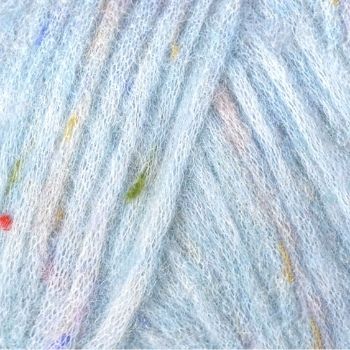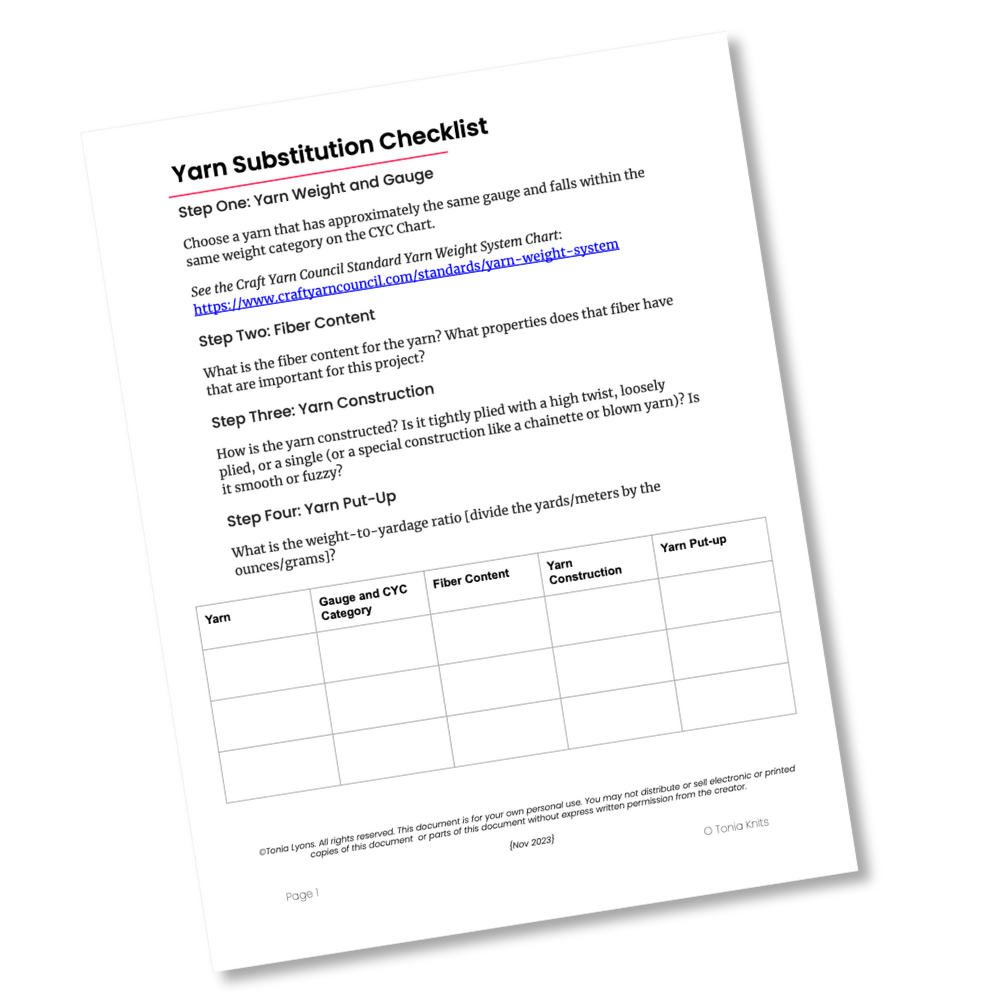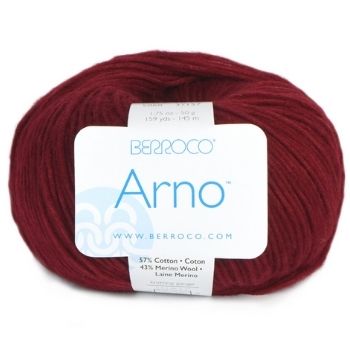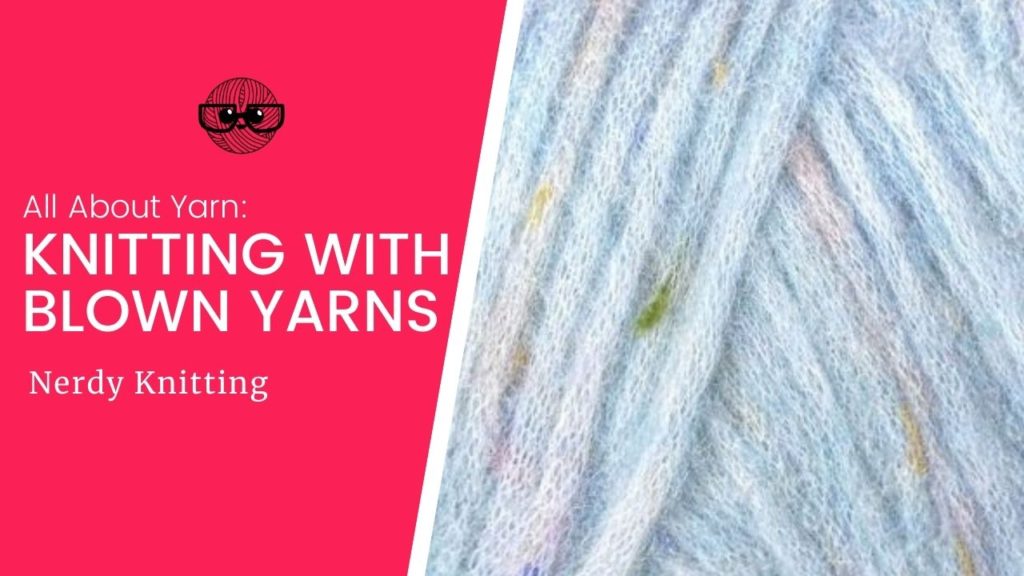Blown yarns are a special type of yarn that can be fun to knit with. It’s considered a specialty yarn because, instead of being plied like a normal yarn, it’s a completely different way to construct a yarn that creates a unique, very lightweight, yarn for knitting.
In this article we’ll look at the following topics:
- What are Blown Yarns?
- Properties of Blown Yarns
- Knitting with Blown Yarns
- Where to Buy Blown Yarns
Let’s take a closer look at blown yarns – how they are constructed, the properties that make them useful for knitting, what it’s like to knit with blown yarns, and some recommendations for purchasing if you’re ready to give knitting with blown yarns a try.
Image Credit: Berroco
Some links below are affiliate links. If you click through and make a purchase I may receive a small commission at no extra cost to you. See the disclosure policy for more information.
What are Blown Yarns?

Blown yarns begin with a mesh tube. Then fibers are ‘blown’ into the tube and catch along the mesh edges of the hollow core. There is no ply or twist to this type of yarn.
The mesh tube is made of a very strong fiber – usually, nylon but other fibers like cotton or silk can be used as well. This gives the yarn its strength, structure, and elasticity. See the image here to get an up-close look at blown yarn construction.
The fibers that are blown into this tube are usually short-staple fibers (often fibers that are difficult to spin on their own). When added to a blown yarn construction, you get the benefit of the natural properties of these fibers while the blown yarn construction helps minimize some of the drawbacks that are inherent to those particular fibers.
When looking closely at the yarn it’s often mistaken for chainette yarns but they are manufactured differently. Chainette yarns are created by taking spun singles or very fine plied yarns and creating braids or I-cords for the final yarn.
Blown yarns, while the hollow tube might resemble (or actually be) a length of chainette yarn, it is used to hold the blown fibers in place.
Learn more about chainette yarns in this article: Chainette Yarn: Everything You Need to Know
Properties of Blown Yarns
Like any yarn, the fibers that are used add their own distinct properties to the yarn. But the actual construction of a yarn plays a large part in the process as well – especially for something as distinct as a blown yarn.
No matter what fibers are included, if the construction is a blown yarn construction, those yarns will be:
- lightweight (because it’s really just a hollow tube)
- fuzzy (because the short fibers are blown directly into the tube)
- elastic (because the construction of the mesh tube adds plenty of elasticity)
- strong (because the fibers used for the mesh tube are very strong)
- warm (because the hollow tube traps air and holds it between the fibers)
This construction method is a great way to give inelastic fibers like alpaca and cotton some additional structure and strength. When fibers like alpaca or cotton are knit on their own the resulting fabric will droop and sag with time because these fibers lack memory. They will continue to stretch but won’t ‘bounce back’ to their original shape.
But when cotton or alpaca are part of a blown yarn, the nylon mesh tube gives the fibers the additional strength, structure, and memory they need and the final garment will be lightweight and hold its shape well.
Because of the construction of this type of yarn, air can travel freely into the tube and become trapped within the tube and the fibers – making it a very warm yarn (especially if the yarn includes alpaca – which is a very good insulator as well).
And, surprisingly, these types of yarns generally pill less often than their traditionally plied counterparts. You can read more about that at this article about blown yarns from YarnSub.com.
One more positive note about blown yarns – because they are so lightweight and actually use less fiber to create than traditionally-plied yarn – they are usually less expensive (you’ll get more yardage for your money).

Knitting with Blown Yarns
Blown yarns are soft and light in the hands as you knit and, because of the tube that holds the fibers (as opposed to plied yarn), you are less likely to split your stitches as you knit. Because of the elastic nature of fiber used for the mesh tube or the construction of the tube itself, this type of yarn is very easy to knit – even if it’s composed of inelastic fibers like cotton.
When knitting with regularly plied cotton yarns there is no elasticity or ‘give’ and that makes it harder on your hands as you knit. The natural elasticity in some fibers (like wool) makes them easier to knit because the natural ‘give’ of the yarn is easier on the hands. But some fibers (especially plant fibers) don’t have any elasticity and can be hard on the hands while knitting.
But when those fibers are used in a blown yarn (or even in chainette or cable-plied yarns) the structure of the yarn construction itself adds the elasticity that the fibers need. This makes them very nice to knit with.
The stitch definition of these types of yarns can vary – depending on the fibers that are used and how tightly structured the hollow tube is. If it’s not very fuzzy and the the tube gives it a nice tight, round shape, the stitch definition can be very, very good – even for something like cables or textured fabric. But if the tube has a loose construction and the included fibers are very fuzzy, that stitch definition can get lost.
If you’re considering this type of yarn for a highly textured project your best option is to swatch with the blown yarn and see how to looks. Even fuzzier, soft-looking cables can be very pretty.
Get the Yarn Substitution Checklist
Fill in the form below to get a free copy of the Four Step Checklist for substituting yarn. Use it for your next knitting project!

Where to Buy Blown Yarns

It’s getting easier to find these specialty yarns. They are still relatively new but the appeal and demand seem to be growing. One thing to note – while they are more readily available in a variety of weights from DK to bulky, you won’t find them in lightweight yarns like superfine or fine weights.
Here are a few recommendations for blown yarns:
- Berroco Arno – DK weight cotton & Merino blend
- Berroco Mochi – heavy worsted weight alpaca, nylon & wool blend
- Cascade Yarns Aereo – heavy worsted weight Merino, alpaca & nylon blend
- Cascade Yarns Cantata – aran weight cotton & Merino blend
- Cascade Yarns Luminosa – aran weight viscose, alpaca & wool blend
- Lana Grossa Sara – aran weight cotton, alpaca & wool blend
- Rowan Alpaca Classic – DK weight alpaca & cotton blend
- Juniper Moon Farm Beatrix – bulky weight Merino wool, angora & nylon blend
- Knit Picks Daydream – DK weight alpaca, nylon & Merino wool blend
- Knit Picks Wonderfluff – bulky weight alpaca, nylon & Merino wool blend
Blown yarns are interesting to knit with – and now you know when it might be a great idea to give this unique yarn a try for your next knitting project. If you’re looking for more information on various yarns and fibers for knitting, take a look at the resources and articles linked below.
More About Yarns & Fibers
- The Knitter’s Book of Yarn by Clara Parkes (available at Amazon)
- Yarn Substitution Made Easy by Carol J. Sulcoski (available at Amazon)
- The Fleece & Fiber Sourcebook by Carol Ekarius & Deborah Robson (available at Amazon)
